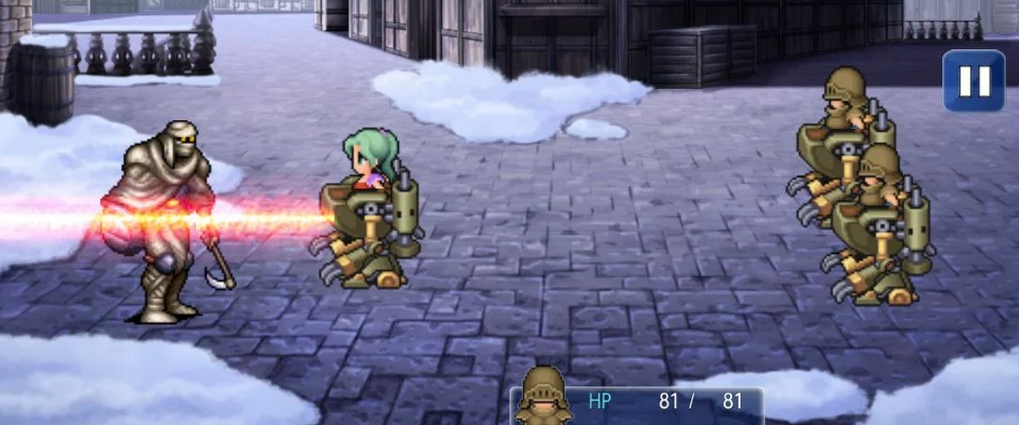
Welcome to Tête-à-tête, a new series where two of our writers remark on interesting topics in the mobile landscape — through chat. This week, we take a look at two recently-released $15 mobile games and ask ourselves, are they worth the investment?
Douglas Soltys: Baldur’s Gate 2 is available for iPad and Final Fantasy VI is now available on Android. Both games are retailing for around $15, well above the average game price for each app store. As a 30 year old male, and thus a gamer old enough to have played both games the first time, I am conflicted about this development for many reasons.
I can still remember the exact moment I first watched FFVI’s opening scene, and now have the ability to play the game for about 1/4 its original cost (cartridges were expensive!) essentially wherever I want. But I am reticent to pay multiple times for games I already own, and $15 is about $15 more than anything I’ve paid for on a mobile app store.
Daniel Bader: Right, $15 is a lot of money for a mobile game, mainly because we’ve been trained to believe that there is a huge gulf between console and mobile platforms. Companies like Square Enix are using iOS and Android to reinvigorate beloved aging franchises to not only introduce novice gamers to the content for the first time but to make it far easier to carry on a game wherever you are.
Over the holidays, I bought XCOM: Enemy Unknown for iOS, a $19.99 (on sale for $9.99 at the time, but still) game that attempts (and succeeds) to offer an identical experience to its console equivalents. With the increasing prevalence of insidious in-app purchase models, I’d rather pay $20 for a full game, knowing that the developers won’t lock away half the game before I pony up dollars for some proprietary currency. It’s a matter of confidence and consistency, two aspects of mobile gaming I no longer believe in.
Douglas: In-app purchases and free-to-play games are a non-starter for me, because they generally lead to empty calorie gaming experiences, and as such, are doomed to be interim blip until a new payment model emerges. Until that happens, developers are caught between a rock and a hard place, because gamers are weary of paying $15+ for a traditional gaming experience, or paying anything for a casual game experience.
I don’t begrudge you paying $20 for XCOM on iOS – it’s a great game, and one that works as a mobile experience. But I’ve already paid for XCOM (and its expansion) on my XBOX 360, and I’m unwilling to pay again just to have it with me on the go, even though I recognize the extra effort Firaxis put into getting it on iOS.
Here’s an interesting question: why are we even paying for games per device at all? I’m now on record as being very excited for PlayStation Now, but even if it fails, I think a Netflix-subscription model is preferable in a world where every device is now a game machine. Let Sony negotiate the content deal with Firaxis, and let me either subscribe to the service or single titles (or publishers) individually. I just want to pay once, knowing XCOM will be ready to go on whatever screen I have in front of me.
Daniel: I like the term empty calorie gaming, but all freemium games are not devoid of substance; a great developer knows how to balance the core gameplay, which should always be free, and the bonuses, which can cost money. Need vs. want.
When great games that cost good money get ruined by the insidious form of free-to-play — think EA’s disastrous reboot of Dungeon Keeper, or most of EA’s oeuvre for that matter — it makes the industry look bad. But I’ve been addicted to Betawork’s Dots for months without paying a cent, and would probably be happy to throw the developer a few bucks for their trouble.
Just as we’ve seen this week, all game developers — even the formerly-infallible ones like Nintendo — need to own up to the fact that smartphones and tablets are eating them for breakfast. I’d be happy to pay $20 for a great Mario or Super Smash Bros experience on the iPad, for example. Square Enix and Sega have already made the transformation, and while console still comprise a good portion of their sales, mobile is the next frontier for them.
The Netflix for games model won’t work so long as the platforms themselves — the Xboxes, PlayStations, iOSes and Androids — yield the distribution power. Apple reportedly pays developers for exclusives, or works with studios to make development easier, and both Sony and Microsoft do the same for their systems. Google would be the obvious choice to work with game developers on a monthly game subscription model, but the great high-quality games would need to be there from the start.
It’s early days, too, in the mobile world: smartphones and tablets are just now approaching the processing capabilities of the Xbox 360 and PlayStation 3, so the landscape for high-quality mobile games could be very different a year or two from now.
Either way, I want to see the poison leeched from the mobile gaming landscape, with punitive free-to-play being the first to go. Unfortunately, with over 90% of developer revenue coming from in-app purchases, that isn’t like to happy anytime soon. The great titles we do have selling for $15 — mostly remakes, or ports of console games — are the ones I’m going to buy, both to support the developers, and to ensure I have great content that isn’t going to nag me to buy tokens halfway through a level.
MobileSyrup may earn a commission from purchases made via our links, which helps fund the journalism we provide free on our website. These links do not influence our editorial content. Support us here.


